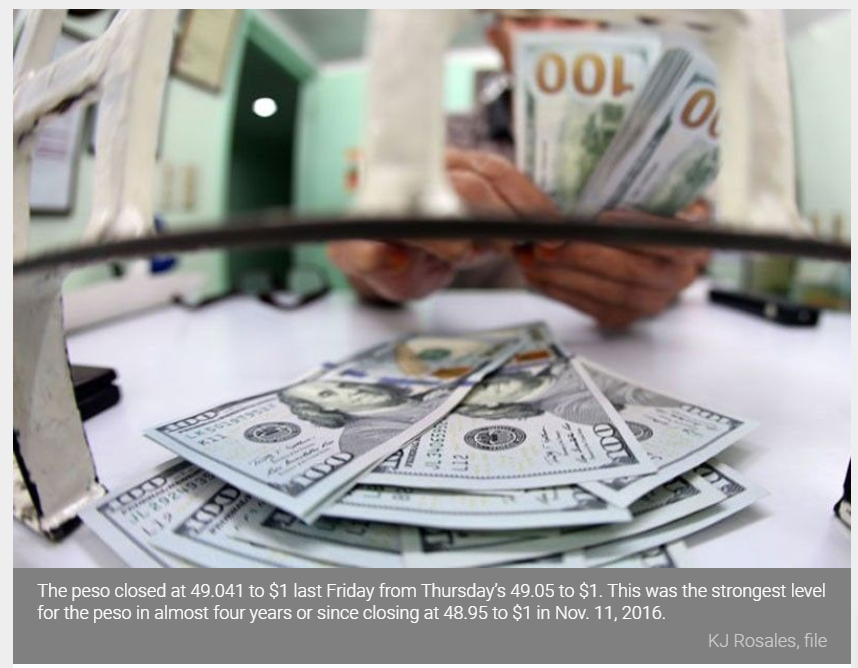Philippines: Peso seen to weaken to 50: $1
MANILA, Philippines — Bank of the Philippine Islands (BPI) expects the peso to weaken back to 50 to $1 level on the back of declining foreign exchange inflows amid the displacement of more overseas Filipino workers (OFWs) due to the global coronavirus pandemic.
BPI lead economist Jun Neri said the local currency is likely to depreciate in the coming months due to the continued decline in remittances as more OFWs are repatriated back to the Philippines from host countries.
“A persistent and more severe decline in remittances in the coming months might push the exchange rate back to the 50 level,” Neri said.
The local currency continued to strengthen against the US dollar, gaining about three percent, making it the second strongest currency after the Japanese yen.
The peso closed at 49.041 to $1 last Friday from Thursday’s 49.05 to $1. This was the strongest level for the peso in almost four years or since closing at 48.95 to $1 in Nov. 11, 2016.
“We continue to take into account the risk presented by remittances,” Neri said.
Latest data from the Bangko Sentral ng Pilipinas (BSP) showed cash remittances coursed through banks fell by 6.4 percent to $11.55 billion from January to May.
Likewise, personal remittances decreased by 6.4 percent to $12.83 billion.
Both cash and personal remittances plunged a little over 19 percent due to the negative effects of the continued limited operating hours of some banks and institutions that provide money transfer services during the lockdown and the repatriation of many OFWs since March amid the COVID-19 pandemic.
The economist warned a substantial decline in remittances could challenge the stability of the exchange rate.
Neri also cited the lack of demand for dollars due to the substantial drop in imports.
“We are revising our peso-dollar year-end forecast to 50.6, given the substantial import contraction and the resulting decline in dollar demand,” Neri said.
Data from the Philippine Statistics Authority (PSA) showed imports plunged 29 percent to $39.03 billion in the first half of the year from $55 billion in the same period last year, while exports slipped by 7.1 percent to $28.43 billion.
This translated to a smaller trade deficit of $10.6 billion from January to June or 48 percent lower than last year’s $20.42 billion.
“Local bond yields may remain low in the near term given the monetary support provided by the BSP. However, risks related to inflation and the exchange rate remain elevated and can put a floor on further policy rate cuts in the near term,” Neri said.
As part of COVID-19 measures that unleashed P1.3 trillion into the financial system, the BSP has slashed interest rates by a cumulative 175 basis points to an all-time low of 2.25 percent, lowered the reserve requirement ratio, entered into a P300 billion repurchase agreement with the Bureau of the Treasury, among others.
BSP Deputy Governor Francisco Dakila Jr. earlier said the Development Budget Coordination Committee (DBCC) had narrowed the foreign exchange assumption to a range of 50 to 52 instead of 50 to 54 versus $1 this year.
For 2021 and 2022, Dakila said the assumption was retained at a range of 50 to 54 per $1.
“The prospect is the peso will remain quite stable. That is an affirmation of the market’s assessment that our external finances remain very stable and our current account will be very financeable,” Dakila said.
Dakila said the DBCC expects exports to decline by 16 percent and imports by 18 percent for this year.
Source: https://www.philstar.com/business/2020/08/09/2033861/peso-seen-weaken-50-1


 Thailand
Thailand




